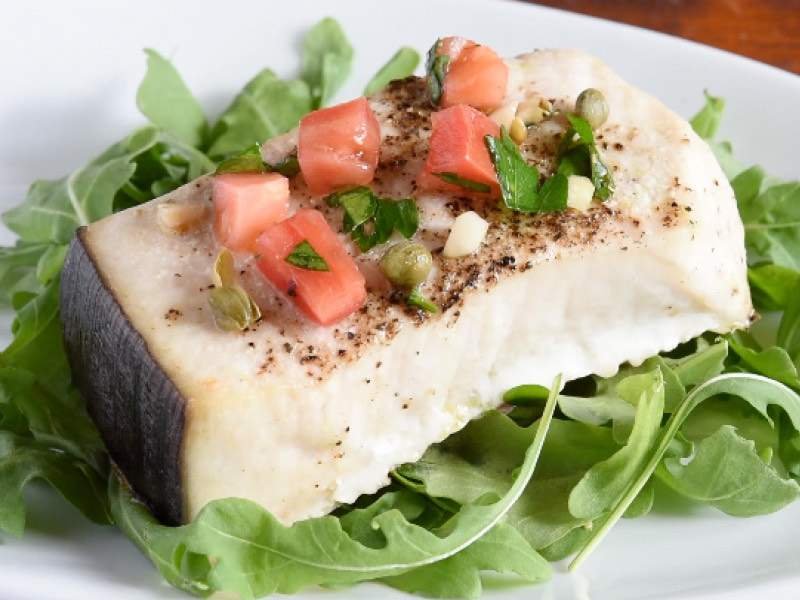Your Essential Guide to Swordfish

Swordfish is one of FultonFishMarket.com's bestsellers and for good reason - it's meaty and delicious, and easy to cook. Our Head of Quality Control, Robert DiGregorgio, shares more about this fast and fascinating fish.
Swordfish, Xiphias gladius, also called Broadbills in some places, are highly migratory fish, can tolerate a wide range of ocean temperatures, and are found all over the world. They are typically in the 10 ft range, but some specimens have been found over 15 ft and weighing over 1,400 lbs. That’s a huge fish, folks. And powerful.
Adult swordfish can swim at 50 mph! Their sword is usually around 1/3 the length of their bodies and swordfish aren’t afraid to use it. They swim into a school of fish and use the sword to slash at their prey, wounding as many as possible before turning back to swallow up as much as they can. Because of their wide range, swordfish have a diverse diet, even though adult swordfish have no teeth. They are predominately fish eaters, all kinds of fish with a lot of squid thrown in. Swordfish stomachs have been found to contain haddock, cod, squid, bluefish, herring, etc. as well as offshore deepwater fish such as viperfish, hatchetfish and lanternfish. These offshore fish are typically found at 150 fathoms (900 feet), but swordfish will go as deep as 2,000 ft or more in their search for food.
Like almost all fish, swordfish are cold blooded, with one important improvement. They have something called countercurrent exchangers - specialized blood vessel structures - which allow them to warm their eyes and brains. This is an important advantage when hunting in deep, cold waters, allowing them to see more clearly and react faster.
As we said, adult swordfish can grow very large and powerful. Because of their size, speed and power, adult swordfish have few predators. Pods of killer whales sometimes target the lone swordfish, and some large, offshore sharks such as the shortfin mako may pursue them. Sometimes these predators are successful, sometimes not. Dead or dying orcas and makos have been found with broken off swords in their heads, revealing the very real danger of desiring swordfish for dinner even for these apex predators. A 1,000 lb fish, with a 4-5 foot sword, swimming at them at 50 mph is the last thing many fish see.
Where are Swordfish Found?
Here in the Northeast, starting in late May or June, swordfish start showing up off Block Island and are numerous off Montauk all summer and fall. Traditionally harvested by harpoon, these days more and more are caught by longline boats. According to NOAA’s stock assessments of 2017, swordfish in the North Atlantic are not overfished and are not subject to overfishing.
What Does Swordfish Taste Like?
Like tuna, swordfish has gained great popularity in our meat-centric culture and exhibits many of the same qualities as does meat, with a similar mouthfeel and texture. The meat is rich and fatty reflecting their diet of mackerel, menhaden and other oily, fatty fish. It has a high moisture content and a rich, full flavor. Swordfish can be cooked just like a steak, and are great grilled, broiled or pan seared.
The meat color varies from creamy to orange - and that would be the famous “pumpkin” swordfish! Some swordfish prefer a diet very high in shrimp and other crustaceans, as well as other fish that also eat a lot of shrimp and crustaceans. The pigment carotenoid from all this shellfish builds up in the meat over time and tints it pinkish-orange. Another example of this is flamingos. They are naturally grayish in color, but because of their diet high in crustaceans the beta-carotene tints their feathers pink! So how does pumpkin swordfish compare to “normal” swordfish? Let me say that when I was selling swordfish all I had to do was cut a pumpkin swordfish in half and it sold itself! The commonly accepted theory is that because its diet was high in shrimp it must taste better. Some people swear by this, and so “pumpkins” usually sell for a higher price.
My opinion? It’s all in the cooking really. I’d rather have a perfectly cooked piece of juicy “normal” swordfish than an overcooked piece of pumpkin swordfish. I’ve eaten swordfish of every shade and color and all things being equal, I’m not sure I can tell the difference. But like I say, some people swear pumpkins eat better and are willing to pay more for the privilege.
What are the Health Benefits of Swordfish?
A question we often receive is: is it safe to eat swordfish? Swordfish not only look good and eat great, they also contain a lot of health benefits. According to the University of California, swordfish provides a healthy source of selenium, which is a nutrient that offers important cancer fighting and heart health benefits. Swordfish is high in protein and loaded with niacin, vitamin B12 and omega 3s. Swordfish is also low in fat and calories, and is cholesterol free, making it a fantastic choice if you’re on a low-fat, high protein diet like Keto, Paleo or Whole30.
Our Best Swordfish Recipes
Grilled Lemon & Garlic Swordfish Kabobs Recipe
These easy grilled swordfish and vegetable skewers are bursting with summer flavors. Our juicy swordfish gets a quick marinade in olive oil, lemon, garlic and oregano, then add your fave veggies and grill until you get those gorgeous grill marks. Serve over rice or stuffed into pita bread with an extra squeeze of lemon.
Try our quick and simple Baked Swordfish recipe for a standout meal. This easy swordfish recipe will definitely be requested again and again.


